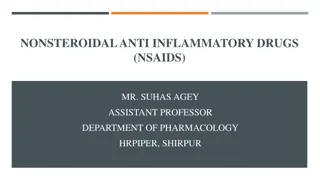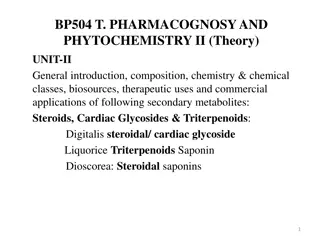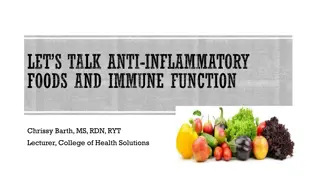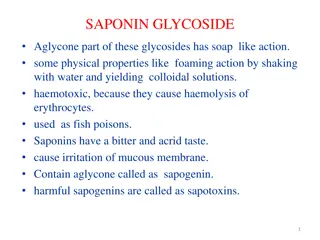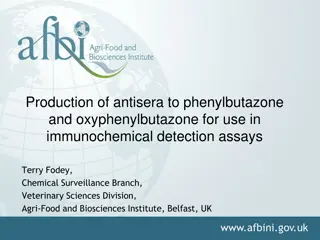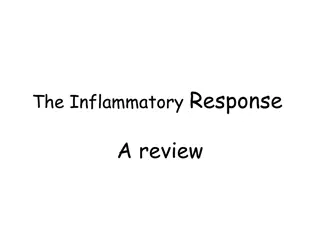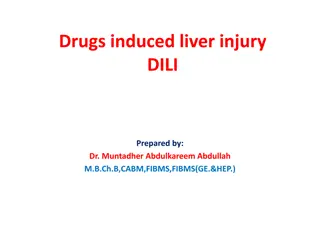Understanding Non-Steroidal Anti-Inflammatory Drugs (NSAIDs): Types and Classification
Non-Steroidal Anti-Inflammatory Drugs (NSAIDs) are a diverse group of medications with analgesic, anti-inflammatory, and antipyretic properties. They act primarily on peripheral pain mechanisms and vary in their selectivity of COX inhibition. This article explores the history, classification, and selectivity of NSAIDs, providing valuable insights into their usage in healthcare.
Download Presentation

Please find below an Image/Link to download the presentation.
The content on the website is provided AS IS for your information and personal use only. It may not be sold, licensed, or shared on other websites without obtaining consent from the author. Download presentation by click this link. If you encounter any issues during the download, it is possible that the publisher has removed the file from their server.
E N D
Presentation Transcript
Non-steroidal anti-inflammatory drugs Dr. Kumari Anjana Assistant Professor Deptt. of Veterinary Pharmacology & Toxicology Bihar Veterinary College, Bihar Animal Sciences University, Patna
Non-steroidal anti-inflammatory drugs (NSAIDs) NSAIDs are heterogeneous group of drugs having analgesic, anti-inflammatory and antipyretic effect. Unlike morphine they do not depress CNS, do not produce physical dependence, have no abuse liability and are weaker analgesics. They are also called non-narcotic, non-opioid or aspirin like analgesics. They act primarily on peripheral pain mechanism, but also in the CNS to raise pain threshold.
History White Willow bark (Salix alba) had been used for many centuries. Salicylic acid was prepared by hydrolysis of the bitter glycosides obtained from White Willow plant. Sodium salicylate 1875 (pain and fever). Acetylsalicylic acid (aspirin) 1899 (Also phenacetin and antipyrine). Phenylbutazone 1949 (anti-inflammatory activity almost similar to corticosteroids), The term NSAIDs coined to designate such drugs. Indomethacin - 1963
Classification Classification of NSAIDs based on chemical groups Salicylates : Sodium salicylate, Acetylsalicylic acid (aspirin), Methylsalicylate. Aniline or : Paracetamol (acetaminophen), Acetanilide, Phenacetin, p- aminophenol derivatives: Aminopyrine, Antipyrine. Pyrazolone derivatives: Phenylbutazone, Oxyphenbutazone, Sulphinpyrazone. Indole & related drugs: Indomethacin, Sulindac. Phenyl acetic acid derivatives: Diclofenac. Propionic acid derivatives: Ibuprofen, Naproxen, Fenoprofen, Ketoprofen. Fenamates: Mefenamic acid. Oxicams derivatives : Piroxicam, Tenoxicam, Meloxicam. Sulfonanilide derivatives: Nimesulide.
Classification of NSAIDs based on selectivity of COX Inhibition: Non-selective COX Inhibitors (Conventional NSAIDs): Salicylates: Aspirin, Diflunisal. Pyrazolone derivatives: Phenylbutazone, Oxyphenbutazone. Indole derivatives: Indomethacin. Propionic acid derivatives: Ibuprofen, Naproxen, Ketoprofen, Flurbiprofen. Anthranilic acid derivatives: Mefenamic acid. Aryl acetic acid derivatives: Diclofenac. Oxicam derivatives: Piroxicam, Tenoxicam. Pyrrolo-pyrrole derivatives: Ketorolac. Preferential COX-2 Inhibitors: Nimesulide, Meloxicam, Nabumetone. Selective COX-2 Inhibitors: Celecoxib, Rofecoxib, Valdecoxib.
Analgesic-antipyretic with poor anti-inflammatory action: p-aminophenol derivatives: Paracetamol (Acetaminophen). Pyrazolone derivatives: Metamizol. Benzoxacine derivatives: Nefopam.
A r a c h i d o n i c a c i d A r a c h i d o n i c a c i d COX-3 COX-2 (inducible)) COX-1 (normal constituent) CNS, Heart, Aorta (normal constituent) Selective COX-2 inhibitor Nonselective NSAID Normal Constituent CNC Kidney Female U/G tract Body homeostasis Stomach Intestine Kidney Platelet Inflammatory Site Macrophages Synoviocytes Endothelial cell Pain Fever Mechanism: COX-1, COX-2 & COX-3 inhibition
Beneficial effects (inhibition of PG synthesis) Analgesia Antipyresis Anti-inflammatory Antithrombotic Closure of ductus arteriosus in newborn
Antipyresis Normal body temperature is maintained by thermoregulatory centre (thermostat) in hypothalamus, which ensures a balance between heat production and heat loss. Fever occurs due to disturbance in the hypothalamic thermostat, which is set at a high temperature. The antipyretics act by resetting the thermostat to normal set-point and then the body temperature regulating mechanisms (dilatation of superficial blood vessels, sweating and increased respiration, promoting heat loss) operate to lower the elevated body temperature to normal level. Normal body temperature is not affected by NSAIDS or antipyretics (at therapeutic doses).
During infections and inflammatory reactions the pathogenic microbial endotoxins cause release of pyrogen interleukin-I from macrophages, which stimulates the generation of prostaglandins (E series) in hypothalamus, which set the thermostat at a higher level resulting in pyrexia or lever. The NSAIDs exert antipyretic effect by irreversibly inhibiting the enzyme cyclo-oxygenase 1 or cyclo-oxygenase 2 or both which catalyze the initial reaction of prostaglandin formation from arachidonic acid in the hypothalamus or through inhibition of a specific COX isoenzyme in the CNS. COX-1 is a constitutive enzyme responsible for physiological synthesis of prostaglandins for tissue homeostasis (including protection on gastric mucosa; PGI2 and PGE2). Whereas, COX-2 is an inducible enzyme responsible for synthesis of prostaglandins which have a role in fever, pain and inflammation.
Anti-inflammatory The inflammatory reactions such as vasodilatation, increased vascular permeability, cell proliferation, pain etc are mediated by the release of a multitude of chemical mediators having varied mechanisms of action. The inflammatory stimuli in the inflammatory cells induce synthesis of prostaglandins through COX2. The NSAIDS exert anti-inflammatory effect by inhibition of prostaglandin synthesis by irreversible inhibition of this enzyme.
Analgesics The NSAIDS are mainly effective against pain associated with arthritis, bursitis, muscular pain, vascular pain, toothache, dysmenorrhoea and bone pain, in all the conditions there is increased synthesis of pain inducers and prostaglandins. The prostaglandins sensitize nociceptors to pain inhibiting prostaglangin irreversible inactivation of COX-1 or COX-2 or both. synthesis through
Antiplatelet aggregator TXA2 is pro-aggregator (COX-1) PGI2 is anti-aggregator Most NSAIDs - effects on TXA2 predominates and inhibits aggregation prolonged bleeding time Aspirin is highly active and acetylates COX in circulation before hepatic 1st pass metabolism Even small dose Antithrombotic effect Myocardial Infarction and other cardiac conditions
Ductus arteriosus It is a shunt connecting the pulmonary artery to the aortic arch Maintained by local PGE2 and PGI2 Closes at birth Failure to close small doses of NSAIDs (aspirin or indomethacin) closes. ( NSAIDs is not used in late pregnancy in late pregnancy premature closure) Other action of NSAIDs: Aspirin can reduce diarrhea that occur after radiation therapy. Sulindac , potent inhibitor of Aldose reductase
Relative Potency of NSAIDs Antipyretic Effect: Aspirin = Paracetamol > Phenacetin > Phenylbutazone Analgesic Effect: Aspirin > Phenacetin & Paracetamol > Phenylbutazone Anti-inflammatory Effect: Phenylbutazone > Aspirin
Thank You Thank You



